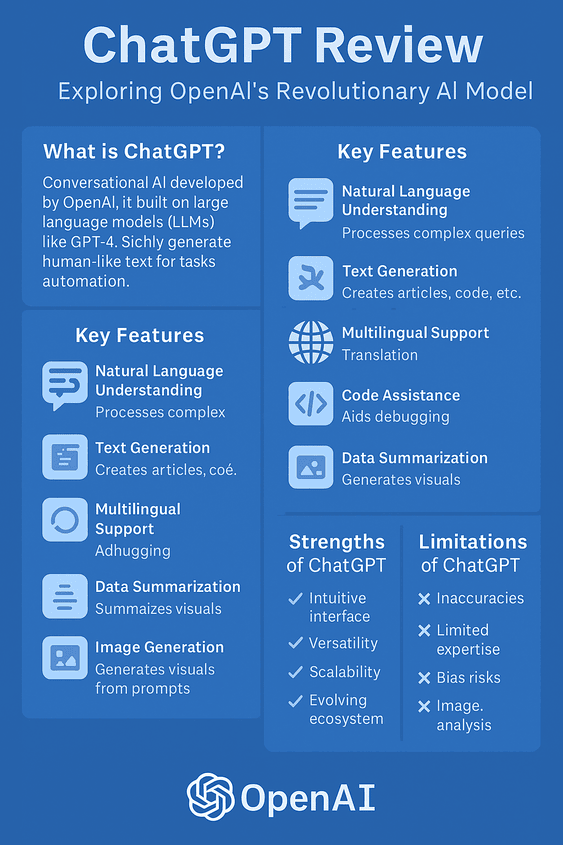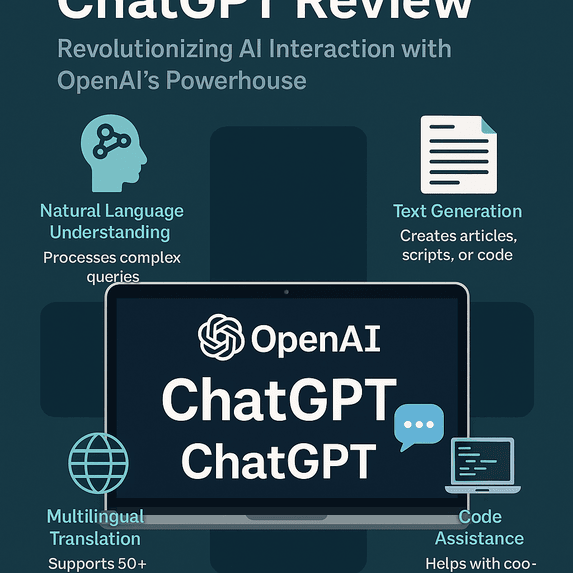What Is ChatGPT?
ChatGPT, developed by OpenAI, is a conversational AI model powered by advanced large language models (LLMs) like GPT-4, designed to generate human-like text for dialogue, task automation, and problem-solving across industries. It leverages natural language processing (NLP) to understand and respond to user queries, making it a versatile tool for both personal and professional applications. Since its launch in 2022, ChatGPT has transformed how users interact with AI, offering intuitive conversational capabilities that rival human communication [ScienceDirect,; ZDNET,].
Key Features of ChatGPT
ChatGPT’s core functionalities, enhanced by AI tools, make it a standout in the generative AI landscape:
- Natural Language Understanding: Processes complex queries with contextual awareness, enabling coherent conversations. OpenAI’s GPT-4 powers this capability [ScienceDirect,].
- Text Generation: Creates articles, scripts, or code snippets, streamlining content creation. Tools like LangChain augment this by structuring outputs for specific tasks [MIT Press,].
- Multilingual Translation: Competes with tools like Google Translate for high-resource languages, improved by GPT-4’s advancements [MIT Press,].
- Code Assistance: Generates, debugs, and explains code, enhancing developer productivity. Integrations with GitHub Copilot amplify this feature [MIT Press,].
- Data Summarization: Condenses large datasets or texts into concise summaries, aided by AI tools like Pinecone for efficient data retrieval [Team-GPT,].
- Custom GPTs: Allows tailored AI models for niche tasks, leveraging OpenAI’s API for integration with productivity platforms [Team-GPT,].
- Image Generation: Creates visuals from text prompts using DALL·E integration, expanding creative applications [Team-GPT,].
Image Caption: ChatGPT’s interface, powered by OpenAI’s GPT-4, delivers seamless AI-driven conversations.
Real-World Use Cases
ChatGPT’s versatility shines across industries, often integrated with AI tools:
- Healthcare: Hospitals use ChatGPT to draft discharge summaries and optimize data, with OpenAI’s API enabling custom medical chatbots [PMC,].
- Tourism: Travel agencies leverage ChatGPT for real-time booking and customer service, enhanced by LangChain for personalized trip planning [Taylor & Francis,].
- Entertainment: Studios employ ChatGPT to generate scripts or song lyrics, with Hugging Face Embeddings refining content for audience preferences [Taylor & Francis,].
- Research: Universities use ChatGPT for hypothesis generation and literature reviews, augmented by Pinecone for efficient source retrieval [ScienceDirect,].
- Finance: Firms automate financial reporting with ChatGPT, using OpenAI’s API for forecasting models [Team-GPT,].
Image Caption: ChatGPT, integrated with AI tools like LangChain, streamlines travel planning for tourism.
What We Love About ChatGPT
ChatGPT’s strengths, bolstered by AI tools, set it apart:
- Intuitive Interface: Its Google-like simplicity makes AI accessible, enhanced by OpenAI’s user-friendly design [Team-GPT,].
- Versatility: Supports diverse tasks, from coding to creative writing, with tools like LangChain tailoring outputs [MIT Press,].
- Scalability: Custom GPTs enable enterprise-grade solutions, leveraging OpenAI’s API for seamless integration [Team-GPT,].
- Continuous Improvement: GPT-4’s advancements in translation and reasoning outpace earlier models, competing with tools like DeepSeek [MIT Press,].
- AI Ecosystem Synergy: Integrates with Pinecone, LangChain, and Hugging Face, amplifying functionality for specialized workflows [Team-GPT,].
What Needs Work

Despite its strengths, ChatGPT has limitations where AI tools could help:
- Inaccuracies: Can generate incorrect or fabricated responses, requiring human oversight. Tools like DeepSeek’s RAG could improve accuracy [MIT Press,].
- Limited Contextual Expertise: Struggles with niche scientific topics, where domain-specific AI models like QWEN could enhance understanding [PMC,].
- Bias Risks: Training data biases may lead to skewed outputs, addressable with regular audits and tools like Hugging Face’s fairness frameworks [PMC,].
- Image Analysis Absence: Cannot review visual content in manuscripts, a gap emerging AI tools for image analysis could fill [PMC,].
Comparing ChatGPT to Alternatives
ChatGPT competes with AI tools like Grok, Perplexity, and DeepSeek. Here’s a comparison:
| Tool | Performance | Pricing | AI Integration |
|---|---|---|---|
| ChatGPT | High, excels in conversation and text generation [Team-GPT,] | Free tier; Plus at $20/month [OpenAI Pricing] | Strong, with OpenAI API and LangChain support [Team-GPT,] |
| Grok | Competitive in reasoning, weaker in creative tasks [ChristianPost,] | Free with limits; subscription via xAI [xAI Pricing] | Integrates with xAI’s ecosystem, less flexible [ChristianPost,] |
| Perplexity | Strong for research, less conversational [ChristianPost,] | Free; Pro at $20/month [Perplexity Pricing] | Uses embeddings for search, no custom model support [ChristianPost,] |
| DeepSeek | High accuracy with RAG, less versatile [ChristianPost,] | Free tier; enterprise pricing varies [DeepSeek Pricing] | RAG enhances accuracy, limited ecosystem [ChristianPost,] |
Pricing
ChatGPT offers a free tier with limited access to GPT-4o, suitable for casual users. The Plus subscription costs $20/month, unlocking advanced features, higher quotas, and custom GPTs. Enterprise plans vary, tailored to organizational needs via OpenAI’s API, with additional costs for integrations like LangChain or Pinecone depending on usage [OpenAI Pricing, https://openai.com/pricing]. For detailed enterprise pricing, visit OpenAI’s official page.
How ChatGPT Is Quietly Changing the Way We Speak
After its meteoric rise to 100 million users in just two months, ChatGPT is now not only transforming how we write and work—but also subtly reshaping how we speak. A recent study from the Max Planck Institute found that users are unconsciously adopting “GPT words” like delve, realm, and meticulous in everyday speech, influenced by language patterns the model repeats. This cultural feedback loop—where humans train AI and then mirror its outputs—raises concerns about linguistic homogenization. As AI becomes a perceived authority, it could unintentionally narrow the diversity of our language and ideas.
Final Verdict
ChatGPT excels as a versatile, AI-powered conversational tool, ideal for researchers, developers, and businesses leveraging OpenAI’s ecosystem and tools like LangChain. Despite limitations in accuracy and niche expertise, its strengths make it a must-have for those seeking scalable AI solutions. Rating: 4.5/5.
